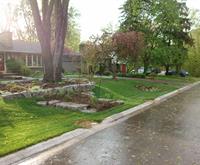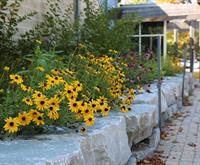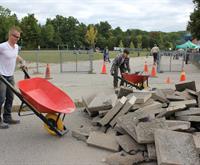Stormwater Management
The practice of stormwater management is constantly evolving.
Beginning in the 1980’s stormwater was managed through ponds which were designed for the purposes of flood control. Stormwater ponds acted as temporary chambers to hold rainfall, melted snow or water runoff, releasing the water slowly after a storm to help prevent flooding.
In the early 1990’s, water quality became an additional concern. So efforts were made to retrofit stormwater ponds to address water quality. The problem became one of stormwater pond maintenance, with many stormwater ponds not achieving their desired results.
The most recent shift in stormwater management is known as “green infrastucture” and “low impact development”. These methods involve trying to direct the water into the ground as closely as possible from where it lands, minimizing the amount of runoff travelling across the ground.
A New Direction to Manage Stormwater
As urban areas in the Lake Simcoe watershed continue to grow, we must continue to explore alternative strategies to stormwater management. The idea behind innovative stormwater management is to reduce the amount of rainwater entering our storm sewers by increasing the amount that infiltrates into the ground.
To better manage stormwater, sustainable Low Impact Development (LID) practices can be applied to new undeveloped lands as part of the subdivision process, and to existing developed lands through retrofitting.
Learn more about stormwater management by viewing one of the following video or case studies:

Residential
The neighbourhoods around Newmarket’s Western Creek are aging with roads in need of repair, while extensive development is increasing risk of flooding downstream during intense storm events. Find out what LID practices were selected as part of this retrofit project.

Industry and Commercial
LSRCA added LID features such as bioswales, curbcuts, and permeable pavement to its aging parking lot. These features will help extend the life of the parking and walking surfaces and increase the number of parking spots. Learn more about LSRCA’s new parking lot features and project outcomes.

Institutions
Staff and the Parent Teacher Association at the St. Nicholas School were looking for a low cost solution to providing a shaded play area. Find out how LID practices were incorporated into the design of the new play area.
Fostering Sustainability through Innovation
The Sustainable Technologies Evaluation Program (STEP) is a multi-agency initiative developed to support broader implementation of sustainable technologies and practices within a Canadian context. Lake Simcoe Region Conservation Authority is a proud partner of STEP and recently developed, alongside Credit Valley Conservation and Toronto and Region Conservation Authorities, the Low Impact Development Treatment Train Tool, an exciting new open-source tool created to help developers, consultants, municipalities and landowners better understand, plan and implement sustainable stormwater practices.

 A New Way to Manage Stormwater
A New Way to Manage Stormwater
We’re engaged in a ground-breaking research study in an effort to improve stormwater management, introduce savings, and address the impacts of urbanization, degraded water quality and climate change.
Read more about the Stormwater Economic Optimization Study
![]() Who to Contact
Who to Contact
Steve Auger
Stormwater Management Coordinator
✆ 905-895-1281
✆ 1-800-465-0437 Toll free
✉ s.auger@LSRCA.on.ca

 Tools
Tools Projects & Documents
Projects & Documents